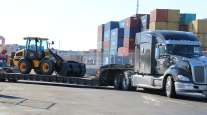Staff Reporter
Rebalanced Supply Chain Still Leaves Empty-Mile Problem

[Stay on top of transportation news: Get TTNews in your inbox.]
The underlying issues causing empty miles and unfilled trucks persist even as a balancing supply chain has softened them, experts warned.
“I think we’ve seen improvements,” Ben Cubitt, senior vice president of consulting at Uber Freight, said. “But the improvements probably fall into two camps, planned and intentional and they just happen because they happen. If you think about it, networks were really disrupted and it’s taken a long time for the transportation networks to get relatively balanced.”
Cubitt pointed to the supply chain gradually getting back to normal after the coronavirus pandemic as one of the unintentional ways empty miles have been reduced. He also noted it can be an indirect consequence of transportation providers pursuing efficiencies more generally.
“Concerts weren’t happening, sporting events weren’t happening,” Cubitt said. “All of that has turned back on so all those lanes are shipping again. And so, people have filled trucks to some varying degree of success with that freight.”

Cubitt
Flock Freight and Drive Research found in a study released March 30 that only 55% of shippers filled their trucks to capacity last year. The combined unutilized space amounted to one in five truckload shipment moving completely empty. The study pointed to the unfilled space and fees as threatening shipper profitability despite a favorable deflationary market.
“Even in a shipper-friendly freight market, too many businesses are still defaulting to inefficient shipping methods,” Kevin McMaster, vice president of sales and operations at Flock Freight, said. “Regardless of the economic environment, shipping empty trucks is just extremely hard to justify as it pertains to not just simple associated costs, but also with our responsibility to the environment.”
McMaster noted there are opportunities for shippers to avoid the usual costs of inefficient shipment runs even as they face growing pressures to deliver goods on time and on budget. He pointed to shared truckload and freight pooling approaches as an example. Flock Freight designed its services around that approach.
“Truckload shippers filled their trucks slightly more often in 2022 compared to 2021,” McMaster said. “But that was more likely caused by a handful of external factors in the market considering that barely half of them are filling their trailers to full capacity.”

McMaster
Cubitt noted it’s tough for individual carriers or shippers to make an impact. But he pointed out transportation networks can become more efficient by better leveraging technology and being more collaborative with data.
“Once the networks are back in balance as much as they can be because the gross inefficiencies have been worked out, how do you impact that,” Cubitt said. “I think companies like Uber, because of our scale and technology, because we see a lot of networks, we have a lot of opportunity to impact that and we’re trying to.”
Uber Freight has worked with its shipper customers to find opportunities to collaborate, such as ensuring a truck bringing an inbound load is likely to get an outbound load. He pointed to drop trailers as being particularly efficient for this approach.
“I think for carriers, for shippers, for technology providers like us, and it’s certainly something that we’re focused on — how do we get better data and visibility into where empty miles are happening,” Cubitt said. “Carriers could provide more information. Technology providers like us should provide more visibility and we’re working to do that. But I think that’s a gap that as an industry we should acknowledge and be a little more vocal about.”

Anthony Marshall of UPS shares the gold standard for an efficient and effective EV maintenance cycle. Hear the program above and at RoadSigns.TTNews.com.
Cubitt warned there is a possibility empty miles could increase in the current environment. There have been indications freight demand is softening so carriers may become more willing to drive further to get a load.
“Empty miles and unfilled trucks tend to reflect the macro environment,” Tanmay Mathur, senior vice president of linehaul at XPO, said. “For the industry as a whole, this softer demand environment has increased the likelihood of empty miles and unfilled trucks in some lanes. At XPO, we’re laser-focused on increasing efficiency in our operations, including how we can load our trucks and route freight as efficiently as possible.”
Mathur actually saw fewer empty miles and unfilled trucks during the pandemic because demand was so strong.
“We’re using route optimization software to minimize the number of terminals a shipment is routed through to reduce miles driven,” Mathur said. “Our pickup and delivery operations leverage machine learning to dictate P&D route sequencing — which maps out a week in advance how to make the freight flow as efficiently as possible. We then use daily models to assess what kind of freight we’re going to pick up, where it’s going and how the trailers should be loaded.”
XPO ranks No. 3 on the Transport Topics Top 100 list of the largest for-hire carriers in North America.
Want more news? Listen to today's daily briefing below or go here for more info:




